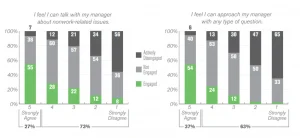Here is a question for you: when you think of job satisfaction, do you assume that a well-paid workforce is a uniformly happy one, and therefore a high-performing one?
Would it surprise you that according to Gallup, 89% of employers think employees leave for more money when the reality is only a mere 12% do? According to Gallup’s State of the American Manager Report, 50% of employees have left a job to get away from a manager and improve their overall life.
That last emphasis is ours. It is important to underline the full impact of a disempowered employee. The opposite also applies. Instilling purpose and trust across your entire organisation builds a coherent, defined and high-performing corporate culture. In turn this yields:
- a lower job turnover,
- higher staff retention,
- lower customer churn,
- and higher employee productivity.
Importantly, this will carry through to an employee’s overall happiness inside the workplace and at home.
It requires a management mind shift. Nurturing each employee from an individual level is not the sole province of your HR department but a ‘C-suite’ concern too. Gallup’s research confirms that building each employee’s strengths is more effective than improving their weaknesses. What’s more, as a manager your approach to their strengths will have a profound impact on engagement.
Did you know, 78% of employees believe the CEO needs to drive any change to their company culture?
This engagement has a keen influence on your organisation’s long-term viability.
Employees whose managers are open and approachable are more engaged.

This is your challenge
How do you affect meaningful employee engagement, reaching each employee in a way that grows their unique career profiles and amplifies their contribution to a high-performance organisation? It is a task that could feel daunting, especially when you are at the helm of a company with a sizeable staff complement extending across countries and continents.
Is intimate, thoughtful employee engagement at scale a contradiction?
A further complication is the current coronavirus pandemic and its impact on ‘business as usual’. Despite the increased physical distance, employees still want an engaging, productive, and enjoyable work experience. This is easier to achieve when you are all sitting together at the same physical site. Can you replicate or even improve the experience when you are restricted to certain sites, and most of your engagement moves online?
The answer is yes. You just need the right solution for employee engagement.
By providing an engaging digital experience, you will attract and retain a skilled workforce passionate about their customers and their needs. In a competitive global economy, the way we communicate and the tools we use are critical.
These are the top 5 ways digital communication can help align your workforce.
1. It encourages your employees’ voice and enhances their empowerment and engagement
Digital tools built in an intelligent workplace will offer you an easy way to communicate in real-time. In addition to keeping employees informed, digital communication and technology will arm all employees throughout your organisation with a voice.
As businesses change, digital platforms will enable a positive and empowered employee experience, allowing them to be more involved. Reciprocity is vital to functional relationships. The act of providing a safe space to make suggestions and feel involved will increase their engagement.
2. Employees are more effective and efficient
 Bureaucracy, outdated tools, siloed behaviour, scant and mediocre communication, and inaccessible information leads to employee frustration and poor employee productivity. A positive employee experience demands that you remove friction from their day-to-day work. Digital technology will help you achieve this.
Bureaucracy, outdated tools, siloed behaviour, scant and mediocre communication, and inaccessible information leads to employee frustration and poor employee productivity. A positive employee experience demands that you remove friction from their day-to-day work. Digital technology will help you achieve this.
Employees want to:
- collaborate and communicate with colleagues and management faster,
- access accurate information more rapidly, and
- get their work done more efficiently.
By ensuring information and people are both easy to retrieve, digital communication platforms will make it much easier for your employees to be productive and get their work done.
3. It helps you create and reinforce your shared purpose and values
Your organisation’s purpose should be an inspirational driver that directs all your activities (such as policy, structure, innovation, processes, performance, or change). A meaningful purpose sets a higher standard of excellence, motivates employees to join ‘your cause’, and attracts customers who love what you do.
At the same time, your organisational values will influence how your employees interact with each other and work together to achieve results. However, many organisations struggle with getting everyone in the company to actually live the values the organisation aspires to.
A digital employee communication platform enables you to ensure that:
- Every employee knows your organisational purpose and values through regular, inspiring communications campaigns and micro-learning programmes;
- There is increased adoption of these values through encouraging managers and employees to recognise and reward those in the business who are driving the organisation’s purpose and living the values; and
- You can easily track the progress of the organisation as a whole as well as compare progress amongst specific departments, geographies or other groups.
The result will not only be the accelerated adoption of your organisation’s purpose and values but, in turn, improvements in the employee experience that will create a more resilient, sustainable, and successful workforce.
4. It allows employees to collaborate successfully even when they are not side by side
 Working separately (and remotely) is here to stay. According to a Forbes’ estimate, 50% of the US workforce was projected to be remote in 2018. In Europe, remote workers increased from 7.7% to 9.8% in the past decade, and this was before COVID-19.
Working separately (and remotely) is here to stay. According to a Forbes’ estimate, 50% of the US workforce was projected to be remote in 2018. In Europe, remote workers increased from 7.7% to 9.8% in the past decade, and this was before COVID-19.
A Gartner survey of company leaders found that 80% plan to allow employees to work remotely at least part of the time after the pandemic and 47% will allow employees to work from home full-time.
In a PwC survey of 669 CEOs, 78% agree that remote collaboration is here to stay for the long term.
While your employees may not be deskbound, there is a good chance you have discouraged regular movement between multiple sites. This means employees accustomed to face-to-face engagement must adapt to working removed from their colleagues.
5. It guides a collaborative corporate culture and drives success
In a global environment with multiple teams and a dispersed workforce, organisational silos will harm your business’s success, especially without digital tools and technologies. It is also easy for departments to guard information, making it inaccessible to the rest of the company when they have no place to share it. Departments like customer service, sales, and your supply chain will suffer when they cannot communicate and collaborate effectively.
Digital employee communication changes all that. By enabling your employees to interact and share ideas, you will:
- build a sense of community and trust,
- encourage innovation, and
- solve problems in real-time.
Digital employee engagement will remove employee communication barriers and transform your employee experience, promoting innovation and growth.
Key takeaways
As geographic distance becomes an accepted business choice, effective digital employee communication will unite your employees more powerfully. Having said that, to realise a holistic, high-performing and connected workforce, complete participation is needed which starts with connecting everyone across the business. And it starts with you, are you ready?
Unleash tomorrow.

